Integrating Agroecological Food Production, Ecological Restoration, Peasants’ Wellbeing, and Agri-Food Biocultural Heritage in Xochimilco, Mexico City
Abstract
:1. Introduction
Xochimilco and the Chinampa System

2. Materials and Methods
2.1. Water Quality
2.2. Existing Markets for Chinampa Products
2.3. Social Organization in Favor of Traditional Agriculture
3. Results
3.1. Water Quality
3.2. Existing Markets for Chinampa Products
The main problems are the lack of knowledge of people about the project and about the cultural and alimentary value of products, as well as the competence of chain grocery stores.
One of the main problems is to obtain a competitive price; as part of what is agroecological, is the social part, [that means] paying a fair price to the producer; and for many people, I think there is still much misinformation about the value of these products compared to those of a standard supermarket […]
It is impossible to compete with the prices of the Central de Abastos when they sell 1 kilo of tomatoes for 10 pesos and we sell them for 46 pesos; then there is a huge difference, but we guarantee that it comes from the chinampa, from a producer that has certain characteristics, while the other one, they do not know where it comes from, and very likely has pesticides, it is cheaper, why? Because there is very much product.
[…] When we sell, they don’t trust a lot in the products of Xochimilco, I mean, there is this common idea that the Xochimilco products are dirty, that the water of Xochimilco is dirty […] they have asked me if we irrigate them with sewage.
In [name of a virtual store], when I had to assign my prices, as a producer, I do not have so much experience in the commercialization, but in production. As a producer, they tell me ‘Assign your prices’, thus I calculate that producing a lettuce cost me 6 pesos […] and then I begin to see the prices assigned by the rest of the fellows, and I think they were in 18 pesos at minimum […] I said to myself ‘I don’t know if I am wrong or what’
3.3. Social Organization in Favor of Traditional Agriculture
We don’t have the conditions to be organic, nor will we have them, because we are chinamperos. Given the quality of land, water, and air... even if you don’t use chemicals, the neighbor does, and then they reach you.
I have always said that our certification is our own work. I have seen fellows who are certified, but their way of working does not support them […] the certification is your own work and showing that [the product] is clean.
We are a cooperative of distribution of goods and services; we seek to work from the solidary economy, agroecology, and food sovereignty; we seek the common good for all participants of the process, from the producer to the consumer.
We do not seek to work with certified producers. It is not something the organization looks for […] that is why we are articulated with the Committee of Participative System of Guarantee […] We look for projects that promote agroecological processes, integrating all components of agroecology, not only the use of traditional practices or free of agrochemicals but also those that encourage organization processes, seed conservation, and community and territory building”
In the past, in chinampas there were beans. We want to encourage beans to be sown again, because [Xochimico producers] are closer than other producers; also, maize, which is now scarce. Producers preferred other trendy products, like kale [...] How do we recuperate things that have disappeared and must be brought from afar?
4. Discussion
4.1. Water Quality
4.2. Existing Markets for Chinampa Products
4.3. Social Organization in Favor of Traditional Agriculture
4.4. Local Effects of Global and Regional Forces
5. Conclusions
Author Contributions
Funding
Institutional Review Board Statement
Informed Consent Statement
Data Availability Statement
Acknowledgments
Conflicts of Interest
References
- Swyngedouw, E. Circulations and Metabolisms: (Hybrid) Natures and (Cyborg) Cities. Sci. Cult. 2006, 15, 105–121. [Google Scholar] [CrossRef]
- Simkin, R.D.; Seto, K.C.; McDonald, R.I.; Jetz, W. Biodiversity Impacts and Conservation Implications of Urban Land Expansion Projected to 2050. Proc. Natl. Acad. Sci. USA 2022, 119, e2117297119. [Google Scholar] [CrossRef] [PubMed]
- Arboleda, M. In the Nature of the Non-City: Expanded Infrastructural Networks and the Political Ecology of Planetary Urbanisation. Antipode 2016, 48, 233–251. [Google Scholar] [CrossRef]
- Elmqvist, T.; Andersson, E.; McPhearson, T.; Bai, X.; Bettencourt, L.; Brondizio, E.S.; Colding, J.; Daily, G.; Folke, C.; Grimm, N.; et al. Urbanization in and for the Anthropocene. Npj Urban Sustain. 2021, 1, 6. [Google Scholar] [CrossRef]
- SDPD. World Urbanization Processes: The 2018 Revision; United Nations Publications: New York, NY, USA, 2018. [Google Scholar]
- Nagendra, H.; Bai, X.; Brondizio, E.S.; Lwasa, S. The Urban South and the Predicament of Global Sustainability. Nat. Sustain. 2018, 1, 341–349. [Google Scholar] [CrossRef]
- Miller, S.W. An Environmental History of Latin America; Cambridge University Press: Cambridge, UK, 2007; ISBN 978-0-521-84853-4. [Google Scholar]
- Vitz, M. A City on a Lake: Urban Political Ecology and the Growth of Mexico City; Radical perspectives; Duke University Press: Durham, UK, 2018; ISBN 978-0-8223-7029-1. [Google Scholar]
- Chaussard, E.; Wdowinski, S.; Cabral-Cano, E.; Amelung, F. Land Subsidence in Central Mexico Detected by ALOS InSAR Time-Series. Remote Sens. Environ. 2014, 140, 94–106. [Google Scholar] [CrossRef]
- Mazari-Hiriart, M.; Zambrano, L. Estudio de Caso: Xochimilco: Su Importancia en la Provisión de Servicios Ecosistémicos. In La biodiversidad en la Ciuad de México; Comisión Nacional Para el Conocimiento y Uso de la Biodiversidad, Secretaría del Medio Ambiente del Distrito Federal: Mexico City, Mexico, 2016; Volume III, pp. 240–255. [Google Scholar]
- Carmona González, E.; Torres Valladares, C.I. The agricultural sustainability of the chinampas in the Valley of Mexico: Case Xochimilco. Rev. Mex. Agronegocios 2017, 34, 699–709. [Google Scholar]
- Zambrano, L.; Rivas, M.I.; Uriel-Sumano, C.; Rojas-Villaseñor, R.; Rubio, M.; Mena, H.; Vázquez-Mendoza, D.L.; Tovar-Garza, A. Adapting Wetland Restoration Practices in Urban Areas: Perspectives from Xochimilco in Mexico City. Ecol. Restor. 2020, 38, 114–123. [Google Scholar] [CrossRef]
- Merlín-Uribe, Y.; González-Esquivel, C.E.; Contreras-Hernández, A.; Zambrano, L.; Moreno-Casasola, P.; Astier, M. Environmental and Socio-Economic Sustainability of Chinampas (Raised Beds) in Xochimilco, Mexico City. Int. J. Agric. Sustain. 2013, 11, 216–233. [Google Scholar] [CrossRef]
- Zambrano, L.; Rojas, R. Xochimilco en el Siglo XXI.; Turner: Mexico City, Mexico, 2021; ISBN 978-607-7711-40-7. [Google Scholar]
- Merlín-Uribe, Y.; Contreras-Hernández, A.; Astier-Calderón, M.; Jensen, O.P.; Zaragoza, R.; Zambrano, L. Urban Expansion into a Protected Natural Area in Mexico City: Alternative Management Scenarios. J. Environ. Plan. Manag. 2013, 56, 398–411. [Google Scholar] [CrossRef]
- Aranda Sánchez, M. Sistema Lacustre “Ejidos de Xochimilco y San Gregorio Atlapulco” Ficha Informativa de Los Humedales de Ramsar (FIR); Secretaría de Medio Ambiente: Mexico City, Mexico, 2004. [Google Scholar]
- AZP El Sistema Agrícola Chinampero de La Ciudad de México, México. Patrim. Econ. Cult. Educ. Para Paz 2017, 2, 246–251.
- GCDMX Programa de Manejo Del Área Natural Protegida, Con Categoría de Zona Sujeta a Conservación Ecológica “Ejidos de Xochimilco y San Gregorio Atlapulco”. In Gaceta Oficial de la Ciudad de México; Secretaría de Medio Ambiente: Mexico City, Mexico, 2018; pp. 27–137.
- Narchi, N.E.; Cristiani, B.C. Subtle Tyranny: Divergent Constructions of Nature and the Erosion of Traditional Ecological Knowledge in Xochimilco. Lat. Am. Perspect. 2015, 42, 90–108. [Google Scholar] [CrossRef] [Green Version]
- Narchi, N.E.; Canabal Cristiani, B. Percepciones de la degradación ambiental entre vecinos y chinamperos del Lago de Xochimilco, México. Soc. Ambiente 2016, 12, 5–29. [Google Scholar] [CrossRef]
- Jiménez, M.; Pérez-Belmont, P.; Schewenius, M.; Lerner, A.M.; Mazari-Hiriart, M. Assessing the Historical Adaptive Cycles of an Urban Social-Ecological System and Its Potential Future Resilience: The Case of Xochimilco, Mexico City. Reg. Environ. Chang. 2020, 20, 7. [Google Scholar] [CrossRef]
- Valiente, E.; Tovar, A.; González, H.; Eslava-Sandoval, D.; Zambrano, L. Creating Refuges for the Axolotl (Ambystoma Mexicanum). Ecol. Restor. 2010, 28, 257–259. [Google Scholar] [CrossRef]
- Canabal Cristiani, B.; Torres-Lima, P.; Burela, G. La Ciudad y Sus Chinampas. El Caso de Xochimilco; Universidad Autónoma Metropolitana Xochimilco: Mexico City, Mexico, 1992. [Google Scholar]
- Mazari-Hiriart, M.; Ponce-de-León, S.; López-Vidal, Y.; Islas-Macías, P.; Amieva-Fernández, R.I.; Quiñones-Falconi, F. Microbiological Implications of Periurban Agriculture and Water Reuse in Mexico City. PLoS ONE 2008, 3, e2305. [Google Scholar] [CrossRef]
- Espinosa, A.C.; Mazari-Hiriart, M.; Espinosa, R.; Maruri-Avidal, L.; Méndez, E.; Arias, C.F. Infectivity and Genome Persistence of Rotavirus and Astrovirus in Groundwater and Surface Water. Water Res. 2008, 42, 2618–2628. [Google Scholar] [CrossRef]
- Espinosa, A.C.; Arias, C.F.; Sánchez-Colón, S.; Mazari-Hiriart, M. Comparative Study of Enteric Viruses, Coliphages and Indicator Bacteria for Evaluating Water Quality in a Tropical High-Altitude System. Environ. Health 2009, 8, 49. [Google Scholar] [CrossRef] [Green Version]
- Diario Oficial de la Federación. Norma Oficial Mexicana NOM-003-SEMARNAT-1997. Que Establece Los Límites Máximos Permisibles de Contaminantes Para Las Aguas Residuales Tratadas Que Se Reúsen En Servicios al Público; Diario Oficial de la Federación: Mexico City, Mexico, 1998. [Google Scholar]
- Diario Oficial de la Federación. Norma Oficial Mexicana NOM-001-SEMARNAT-2022 Que Establece Los Límites Máximos Permisibles de Contaminantes En Descargas de Aguas Residuales y Bienes Nacionales; Diario Oficial de la Federación: Mexico City, Mexico, 2022. [Google Scholar]
- INEGI Conjunto de Datos de Información Topográfica. 2013. Available online: https://www.inegi.org.mx/app/mapas/, (accessed on 25 March 2022).
- SEDEMA Áreas Naturales Protegidas (ANP) Por Nivel y Categoría 2020. Available online: https://datos.cdmx.gob.mx/dataset/areas-naturales-protegidas (accessed on 8 April 2022).
- INEGI Marco Geoestadístico Nacional 2021. Available online: https://www.inegi.org.mx/temas/mg/#Mapa (accessed on 10 May 2022).
- Crossley, P.L. Sub-Irrigation in Wetland Agriculture. Agric. Hum. Values 2004, 21, 191–205. [Google Scholar] [CrossRef]
- Armillas, P. Gardens on Swamps. Archeological Research Verifies Historical Data on Aztec Land Reclamation in the Valley of Mexico. Science 1971, 174, 653–661. [Google Scholar] [CrossRef] [Green Version]
- Ezcurra, E.; Mazari-Hiriart, M.; Pisanty, I.; Aguilar, A.G. La Cuenca de México. Aspectos Ambientales Críticos y Sustentabilidad; Fondo de Cultura Económica: Mexico City, Mexico, 2006. [Google Scholar]
- Torres-Lima, P.; Conway-Gómez, K.; Buentello-Sánchez, R. Socio-Environmental Perception of an Urban Wetland and Sustainability Scenarios: A Case Study in Mexico City. Wetlands 2018, 38, 169–181. [Google Scholar] [CrossRef]
- Rubio, M.; Figueroa, F.; Zambrano, L. Dissonant Views of Socioecological Problems: Local Perspectives and Conservation Policies in Xochimilco, Mexico. Conserv. Soc. 2020, 18, 207. [Google Scholar] [CrossRef]
- Pérez-Belmont, P.; Lerner, A.M.; Mazari-Hiriart, M.; Valiente, E. The Survival of Agriculture on the Edge: Perceptions of Push and Pull Factors for the Persistence of the Ancient Chinampas of Xochimilco, Mexico City. J. Rural Stud. 2021, 86, 452–462. [Google Scholar] [CrossRef]
- Aguilar, A.G.; Santos, C. Informal Settlements’ Needs and Environmental Conservation in Mexico City: An Unsolved Challenge for Land-Use Policy. Land Use Policy 2011, 28, 649–662. [Google Scholar] [CrossRef]
- Durand, L.; Pardo Núñez, J. Consumir y Resistir: Los Mercados Alternativos de Alimentos en la Ciudad de México. In Naturaleza y Neoliberalismo en América Latina; UNAM, Centro Regional de Investigaciones Multidisciplinarias: Cuernavaca, Mexico, 2020; pp. 467–503. ISBN 978-607-30-2960-5. [Google Scholar]
- Eakin, H.; Shelton, R.; Siqueiros-Garcia, J.M.; Charli-Joseph, L.; Manuel-Navarrete, D. Loss and Social-Ecological Transformation: Pathways of Change in Xochimilco, Mexico. Ecol. Soc. 2019, 24, 1–12. [Google Scholar] [CrossRef]
- American Public Health Association (APHA). Standard Methods for the Examination of Water and Wastewater, 22nd ed.; Rice, E.W., Baird, R.B., Eaton, A.D., Clesceri, L.S., Eds.; American Public Health Association; American Water Works Association; Water Environmental Federation: Washington, DC, USA, 2012. [Google Scholar]
- Espinosa, A.C.; Jesudhasan, P.; Arredondo, R.; Cepeda, M.; Mazari-Hiriart, M.; Mena, K.D.; Pillai, S.D. Quantifying the Reduction in Potential Health Risks by Determining the Sensitivity of Poliovirus Type 1 Chat Strain and Rotavirus SA-11 to Electron Beam Irradiation of Iceberg Lettuce and Spinach. Appl. Environ. Microbiol. 2012, 78, 988–993. [Google Scholar] [CrossRef] [PubMed] [Green Version]
- Pérez-Belmont, P. Análisis Integral de Un Agroecosistema Periurbano en Rehabilitación, Ciudad de México. Master’s Thesis, Universidad Nacional Autónoma de México, Mexico City, Mexico, 2014. [Google Scholar]
- World Health Organization. Health Guidelines for the Use of Wastewater in Agriculture and Aquaculture; Report of a WHO Scientific Group; World Health Organization Press: Geneva, Switzerland, 1989. [Google Scholar]
- World Health Organization. Guidelines for Drinking-Water Quality; 4th Incorporating the First Addendum; World Health Organization: Geneva, Switzerland, 2017. [Google Scholar]
- CODEX ALIMENTARIUS. Norma General del Codex Para los Contaminantes y las Toxinas Presentes en los Alimentos y Piensos. CODEX STAN 193-1995, 1995. FAO, OMS. Available online: http://files.eacce.org.ma/pj/1438146474.pdf (accessed on 25 March 2022).
- Schefferm, M. Ecology of Shallow Lakes; Chapman and Hall: London, UK, 1998. [Google Scholar]
- Scheffer, M.; Carpenter, S.R. Catastrophic Regime Shifts in Ecosystems: Linking Theory to Observation. Trends Ecol. Evol. 2003, 18, 648–656. [Google Scholar] [CrossRef]
- Secretaría de Medio Ambiente. Gaceta Oficial de la Ciudad de México Requisitos, Lineamientos y Especificaciones Técnicas Para La Producción Agroecológica en el Suelo de Conservación de la Ciudad de México NADF-002_RNAT-2019; Secretaría de Medio Ambiente: Mexico City, Mexico, 2021. [Google Scholar]
- Solís, C.; Sandoval, J.; Pérez-Vega, H.; Mazari-Hiriart, M. Irrigation Water Quality in Southern Mexico City Based on Bacterial and Heavy Metal Analyses. Nucl. Instrum. Methods Phys. Res. Sect. B Beam Interact. Mater. At. 2006, 249, 592–595. [Google Scholar] [CrossRef]
- Mutune, A.N.; Makobe, M.A.; Abukutsa-Onyango, M.O.O. Heavy Metal Content of Selected African Leafy Vegetables Planted in Urban and Peri-Urban Nairobi, Kenya. Afr. J. Environ. Sci. Technol. 2014, 8, 66–74. [Google Scholar] [CrossRef] [Green Version]
- Akande, F.O.; Ajayi, S.A. Assessment of Heavy Metals Level in Soil and Vegetables Grown in Peri-Urban Farms around Osun State and the Associated Human Health Risk. Int. J. Environ. Agric. Biotechnol. 2017, 2, 3250–3261. [Google Scholar] [CrossRef]
- Vazhacharickal, P.J.; Gurav, T.; Chandrasekharam, D. Heavy Metal Signatures in Urban and Peri-Urban Agricultural Soils across the Mumbai Metropolitan Region, India. Nutr. Cycl. Agroecosyst. 2019, 115, 295–312. [Google Scholar] [CrossRef]
- McKibben, B. Deep Economy: The Wealth of Communities and the Durable Future, by Bill McKibben; St. Martin’s Griffin: New York, NY, USA, 2007. [Google Scholar]
- Li, M.; Jia, N.; Lenzen, M.; Malik, A.; Wei, L.; Jin, Y.; Raubenheimer, D. Global Food-Miles Account for Nearly 20% of Total Food-Systems Emissions. Nat. Food 2022, 3, 445–453. [Google Scholar] [CrossRef]
- Menezes, F. Food Sovereignty: A Vital Requirement for Food Security in the Context of Globalization. Development 2001, 44, 29–33. [Google Scholar] [CrossRef]
- Nigh, R.; González Cabañas, A.A. Reflexive Consumer Markets as Opportunities for New Peasant Farmers in Mexico and France: Constructing Food Sovereignty Through Alternative Food Networks. Agroecol. Sustain. Food Syst. 2015, 39, 317–341. [Google Scholar] [CrossRef]
- Azamar Alonso, A.; Solís Tepexpa, S.; González Gallardo, G.G. Análisis social y ambiental de los programas de rescate en Xochimilco. Expr. Económica 2019, 43, 25–42. [Google Scholar] [CrossRef]
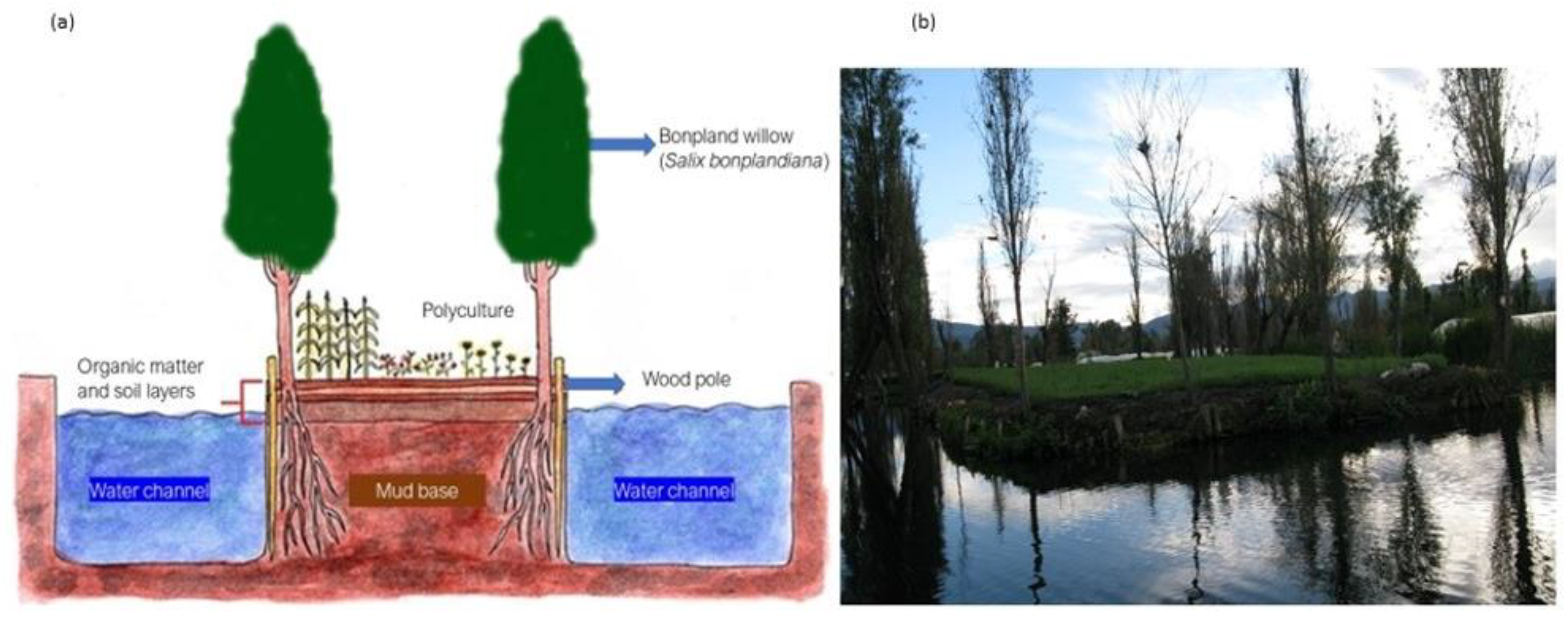
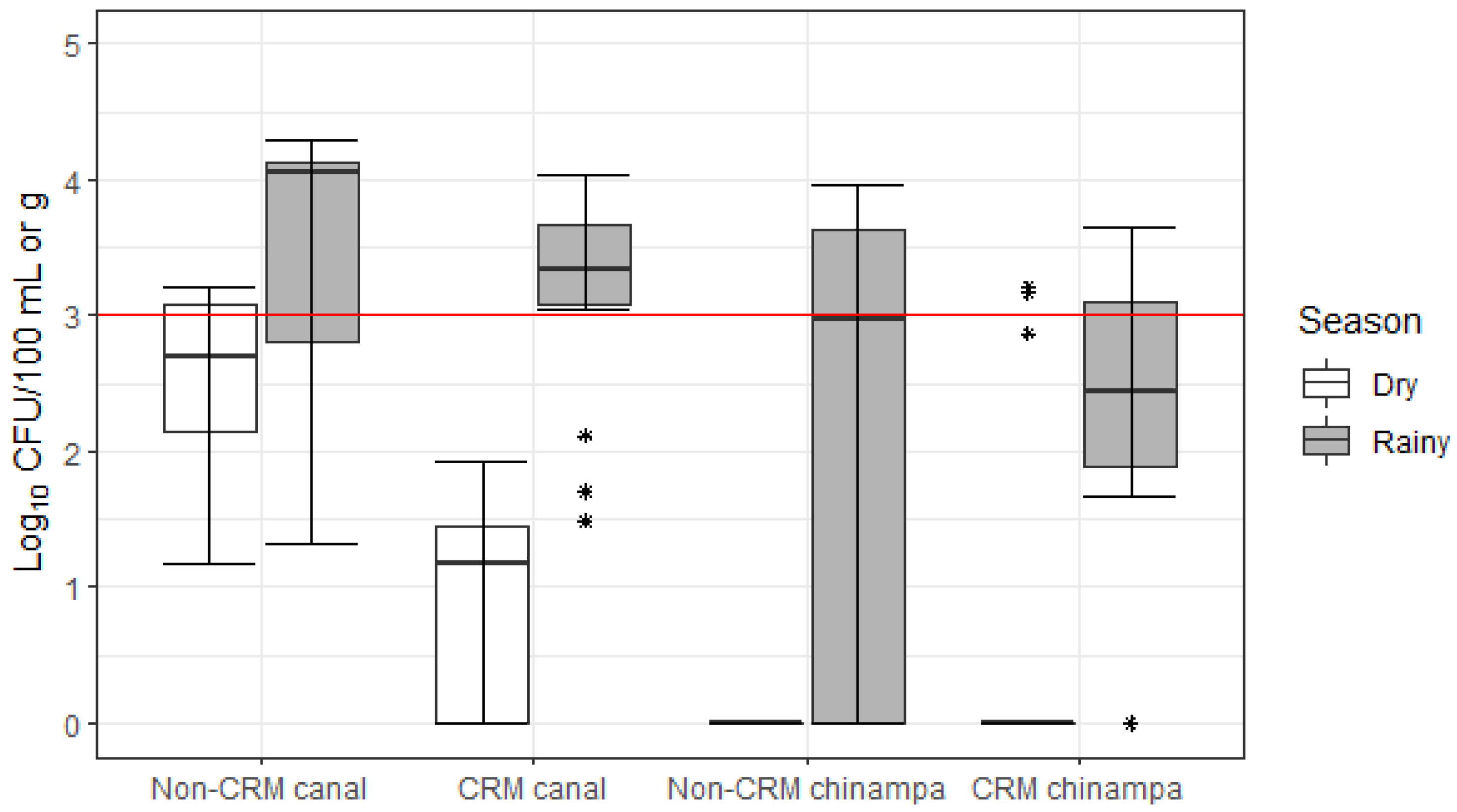

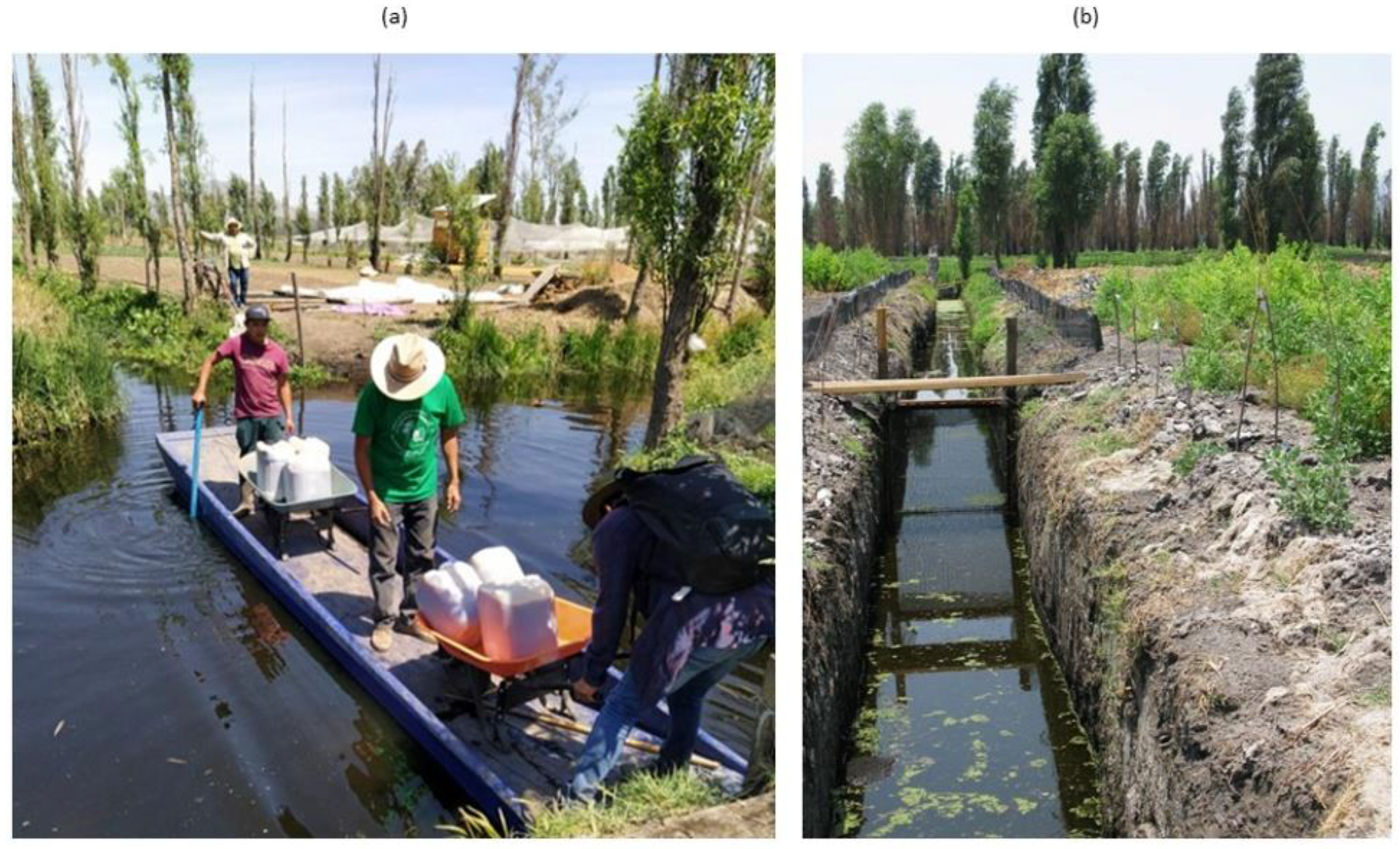
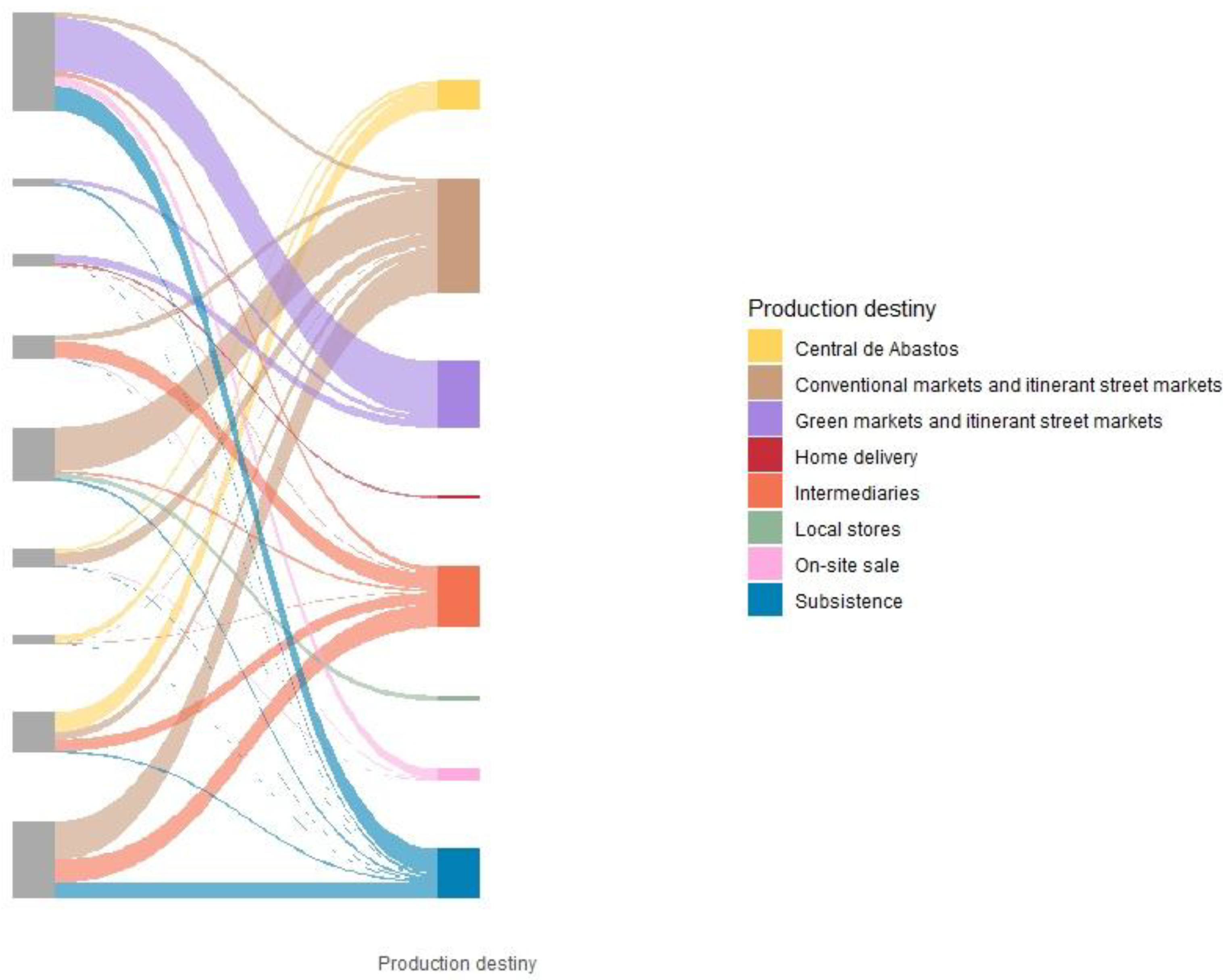
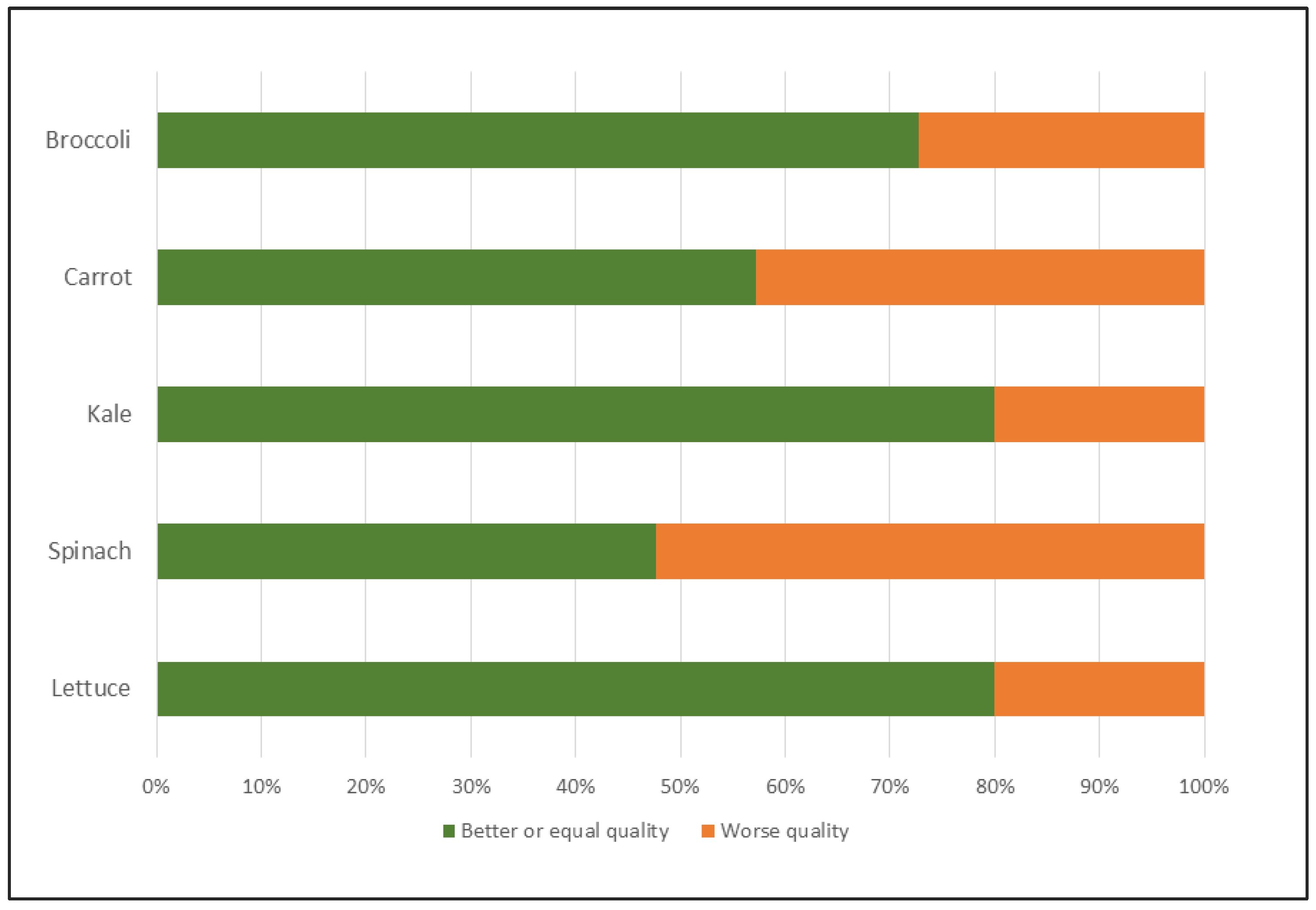
Publisher’s Note: MDPI stays neutral with regard to jurisdictional claims in published maps and institutional affiliations. |
© 2022 by the authors. Licensee MDPI, Basel, Switzerland. This article is an open access article distributed under the terms and conditions of the Creative Commons Attribution (CC BY) license (https://creativecommons.org/licenses/by/4.0/).
Share and Cite
Figueroa, F.; Puente-Uribe, M.B.; Arteaga-Ledesma, D.; Espinosa-García, A.C.; Tapia-Palacios, M.A.; Silva-Magaña, M.A.; Mazari-Hiriart, M.; Arroyo-Lambaer, D.; Revollo-Fernández, D.; Sumano, C.; et al. Integrating Agroecological Food Production, Ecological Restoration, Peasants’ Wellbeing, and Agri-Food Biocultural Heritage in Xochimilco, Mexico City. Sustainability 2022, 14, 9641. https://doi.org/10.3390/su14159641
Figueroa F, Puente-Uribe MB, Arteaga-Ledesma D, Espinosa-García AC, Tapia-Palacios MA, Silva-Magaña MA, Mazari-Hiriart M, Arroyo-Lambaer D, Revollo-Fernández D, Sumano C, et al. Integrating Agroecological Food Production, Ecological Restoration, Peasants’ Wellbeing, and Agri-Food Biocultural Heritage in Xochimilco, Mexico City. Sustainability. 2022; 14(15):9641. https://doi.org/10.3390/su14159641
Chicago/Turabian StyleFigueroa, Fernanda, Martha B. Puente-Uribe, David Arteaga-Ledesma, Ana C. Espinosa-García, Marco A. Tapia-Palacios, Miguel A. Silva-Magaña, Marisa Mazari-Hiriart, Denise Arroyo-Lambaer, Daniel Revollo-Fernández, Carlos Sumano, and et al. 2022. "Integrating Agroecological Food Production, Ecological Restoration, Peasants’ Wellbeing, and Agri-Food Biocultural Heritage in Xochimilco, Mexico City" Sustainability 14, no. 15: 9641. https://doi.org/10.3390/su14159641
APA StyleFigueroa, F., Puente-Uribe, M. B., Arteaga-Ledesma, D., Espinosa-García, A. C., Tapia-Palacios, M. A., Silva-Magaña, M. A., Mazari-Hiriart, M., Arroyo-Lambaer, D., Revollo-Fernández, D., Sumano, C., Rivas, M. I., Jiménez-Serna, A., Covarrubias, M., & Zambrano, L. (2022). Integrating Agroecological Food Production, Ecological Restoration, Peasants’ Wellbeing, and Agri-Food Biocultural Heritage in Xochimilco, Mexico City. Sustainability, 14(15), 9641. https://doi.org/10.3390/su14159641





